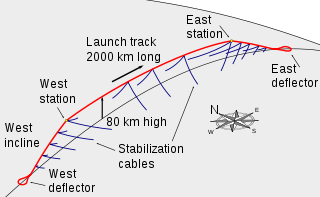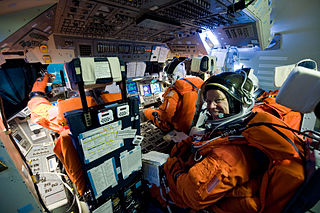
A space suit or spacesuit is a garment worn to keep a human alive in the harsh environment of outer space, vacuum and temperature extremes. Space suits are often worn inside spacecraft as a safety precaution in case of loss of cabin pressure, and are necessary for extravehicular activity (EVA), work done outside spacecraft. Space suits have been worn for such work in Earth orbit, on the surface of the Moon, and en route back to Earth from the Moon. Modern space suits augment the basic pressure garment with a complex system of equipment and environmental systems designed to keep the wearer comfortable, and to minimize the effort required to bend the limbs, resisting a soft pressure garment's natural tendency to stiffen against the vacuum. A self-contained oxygen supply and environmental control system is frequently employed to allow complete freedom of movement, independent of the spacecraft.

Elliot McKay See Jr. was an American engineer, naval aviator, test pilot and NASA astronaut.

Simplified Aid For EVA Rescue (SAFER) is a small, self-contained, propulsive backpack system worn during spacewalks, to be used in case of emergency only. If an untethered astronaut were to lose physical contact with the vessel, it would provide free-flying mobility to return to it. It is worn on spacewalks outside the International Space Station (ISS), and was worn on spacewalks outside the Space Shuttle. So far, there has not been an emergency in which it was needed. SAFER is a small, simplified version of the Manned Maneuvering Unit (MMU), which was used for regular maneuvering.

The European Robotic Arm (ERA) is a robotic arm that is attached to the Russian Orbital Segment (ROS) of the International Space Station. Launched to the ISS in 2021; it is the first robotic arm that is able to work on the Russian Segment of the station. The arm supplements the two Russian Strela cargo cranes that were originally installed on the Pirs module, but were later moved to the docking compartment Poisk and Zarya module.

Artificial gravity is the creation of an inertial force that mimics the effects of a gravitational force, usually by rotation. Artificial gravity, or rotational gravity, is thus the appearance of a centrifugal force in a rotating frame of reference, as opposed to the force experienced in linear acceleration, which by the equivalence principle is indistinguishable from gravity. In a more general sense, "artificial gravity" may also refer to the effect of linear acceleration, e.g. by means of a rocket engine.

A launch loop, or Lofstrom loop, is a proposed system for launching objects into orbit using a moving cable-like system situated inside a sheath attached to the Earth at two ends and suspended above the atmosphere in the middle. The design concept was published by Keith Lofstrom and describes an active structure maglev cable transport system that would be around 2,000 km (1,240 mi) long and maintained at an altitude of up to 80 km (50 mi). A launch loop would be held up at this altitude by the momentum of a belt that circulates around the structure. This circulation, in effect, transfers the weight of the structure onto a pair of magnetic bearings, one at each end, which support it.

Space Camp is an educational camp in Huntsville, Alabama, on the grounds of the U.S. Space & Rocket Center museum at NASA's Marshall Space Flight Center. It provides residential and educational programs for children and adults on themes such as space exploration, aviation and robotics. The camp is run by a state government agency, the Alabama Space Science Exhibit Commission. More than 900,000 campers have graduated since 1982, including several who became astronauts.
Mission: Space is a space-themed pavilion and attached centrifugal motion simulator attraction located on the eastern side of Future World at Epcot, a theme park at the Walt Disney World Resort in Bay Lake, Florida. The attraction simulates what an astronaut might experience aboard a spacecraft on a mission to Mars, from the higher g-force of liftoff to the speculative hypersleep. The pavilion includes a gift shop titled Mission Space: Cargo Bay, an interactive children's play area called the Advanced Training Lab, and a restaurant titled Space 220.

A space toilet or zero-gravity toilet is a toilet that can be used in a weightless environment. In the absence of weight, the collection and retention of liquid and solid waste is directed by use of airflow. Since the air used to direct the waste is returned to the cabin, it is filtered beforehand to control odour and cleanse bacteria. In older systems, wastewater is vented into space, and any solids are compressed and stored for removal upon landing. More modern systems expose solid waste to vacuum pressures to kill bacteria, which prevents odor problems and kills pathogens.

Lunar escape systems (LESS) were a series of emergency vehicles designed for never-flown long-duration Apollo missions. Because these missions were even more hypothetical than the planned cancelled Apollo missions, the designs were never constructed. This concept was an outgrowth of the Lunar Flying Vehicle designed by Bell Aerospace.

The Neutral Buoyancy Laboratory (NBL) is an astronaut training facility and neutral buoyancy pool operated by NASA and located at the Sonny Carter Training Facility, near the Johnson Space Center in Houston, Texas. The NBL's main feature is a large indoor pool of water, in which astronauts may perform simulated EVA tasks in preparation for upcoming missions. Trainees wear suits designed to provide neutral buoyancy to simulate the microgravity that astronauts would experience during spaceflight.

A parallel manipulator is a mechanical system that uses several computer-controlled serial chains to support a single platform, or end-effector. Perhaps, the best known parallel manipulator is formed from six linear actuators that support a movable base for devices such as flight simulators. This device is called a Stewart platform or the Gough-Stewart platform in recognition of the engineers who first designed and used them.

The Shuttle Mission Simulator (SMS) consisted of two simulators in Building 5 and one simulator in Building 35 of Johnson Space Center. The fixed-base simulators included high-fidelity mockups of the flight deck of a Space Shuttle, as well as a low-fidelity mockup of the middeck. The facility in Building 5 was known as the Fixed Base Simulator (FBS), while the facility in Building 35 was known as the GNS. The motion-base simulator consisted of the forward part of the flight deck of the Space Shuttle. It utilized a six-axis hexapod motion system with an additional extended pitch axis to provide motion cuing for all phases of flight.

Cosmodome is a space science museum and education centre located in Laval, Quebec, Canada. Cosmodome is the home to both Space Camp Canada and the Space Science Centre. Space Camp Canada welcomed its first campers in July 1994 while the Space Science Centre opened its doors to the public in December 1994.

The Neutral Buoyancy Simulator was a neutral buoyancy pool located at NASA's George C. Marshall Space Flight Center (MSFC). Engineers and astronauts developed hardware and practiced procedures in this tank from its completion in 1968 through its decommissioning in 1997. Marshall recognized the need for underwater simulations of extra-vehicular activities (EVAs) and developed three successively larger tanks for the purpose. The Neutral Buoyancy Simulator contributed significantly to the American crewed space program. Skylab, the Space Shuttle, Hubble Space Telescope, and the International Space Station have all benefited from the Neutral Buoyancy Simulator. Until Johnson Space Center constructed the Weightless Environment Test Facility in the mid-1970s, MSFC had the only NASA-owned test facility that allowed engineers and astronauts to become familiar with the dynamics of body motion under weightless conditions.
3D Aerobatics or 3D flying is a form of flying using flying aircraft to perform specific aerial maneuvers. They are usually performed when the aircraft had been intentionally placed in a stalled position.
Human analog missions are activities undertaken on Earth in various environments to simulate aspects of human missions to other worlds, including the Moon, asteroids, and Mars. These remote field tests are performed in locations that are identified based on their physical similarities to the extreme space environments of a target mission. Such activities are undertaken to test hardware and operational concepts in relevant environments.

Neutral buoyancy simulation with astronauts immersed in a neutral buoyancy pool, in pressure suits, can help to prepare astronauts for the difficult task of working while outside a spacecraft in an apparently weightless environment.

Astronaut training describes the complex process of preparing astronauts in regions around the world for their space missions before, during and after the flight, which includes medical tests, physical training, extra-vehicular activity (EVA) training, procedure training, rehabilitation process, as well as training on experiments they will accomplish during their stay in space.

A neutral buoyancy pool or neutral buoyancy tank is a pool of water in which neutral buoyancy is used to train astronauts for extravehicular activity and the development of procedures. These pools began to be used in the 1960s and were initially just recreational swimming pools; dedicated facilities would later be built.